Tesco: HRM Functions, Practices, and Employment Legislation
VerifiedAdded on 2023/02/02
|16
|4800
|57
Report
AI Summary
This report provides a comprehensive overview of Human Resource Management (HRM) principles and practices, using Tesco as a case study. It begins with an introduction to HRM, outlining its purpose and the key roles and responsibilities of the HR function. The report then delves into workforce planning, recruitment and selection, training and development, performance management, and reward systems. It explores various approaches and their effectiveness, including internal and external recruitment methods, different training strategies, and performance management techniques. The report also examines employee relations, employee engagement, flexible working practices, and the concept of an employer of choice. Furthermore, it discusses key aspects of employment legislation and how it impacts decision-making and achieving business objectives. The report includes case study examples to illustrate different HR practices and concludes with a discussion on the application of HRM practices in a work-related context, emphasizing the use of technology, online resources, and digital platforms to improve recruitment and selection processes. Overall, the report offers valuable insights into the practical application of HRM principles within a large retail organization.
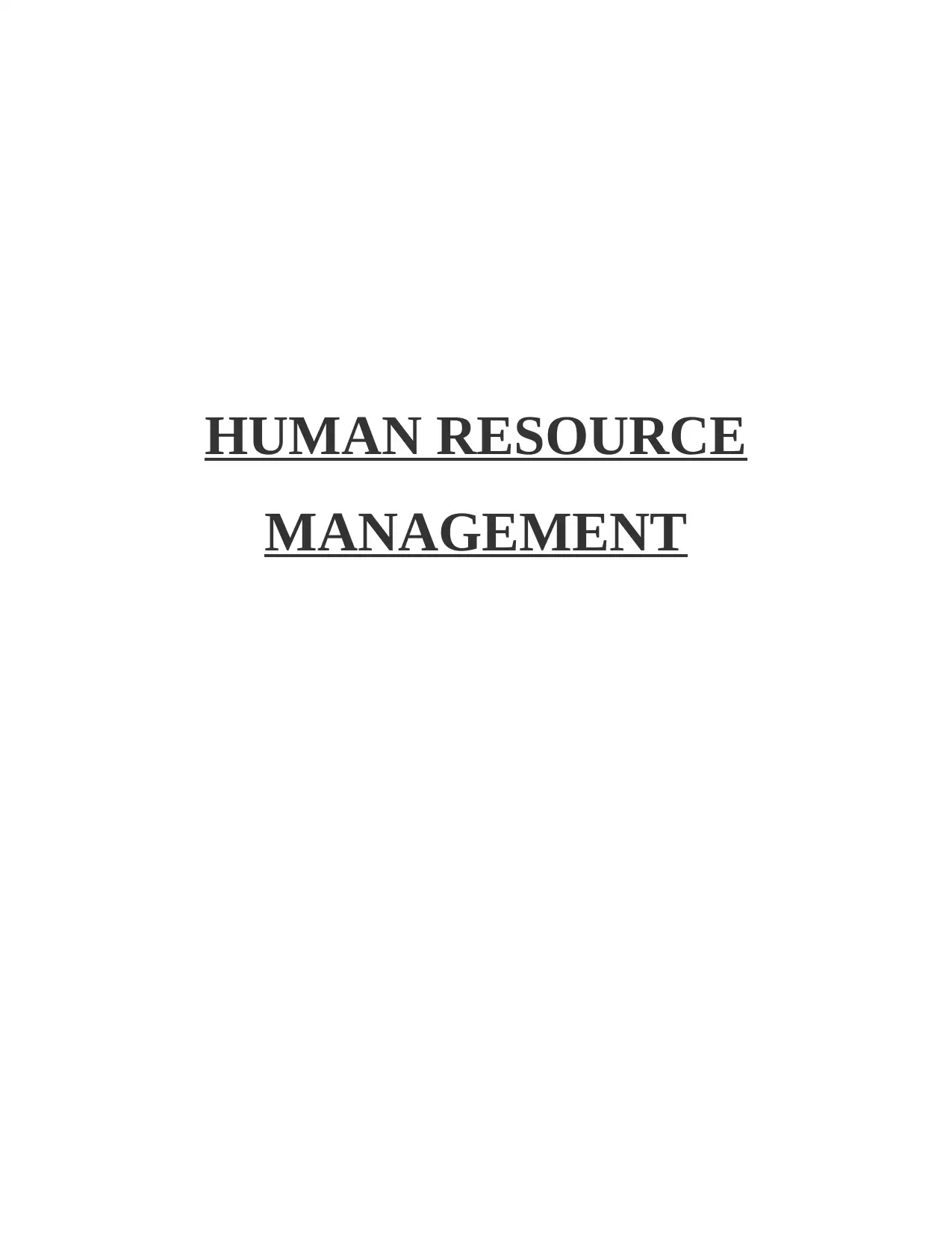
HUMAN RESOURCE
MANAGEMENT
MANAGEMENT
Paraphrase This Document
Need a fresh take? Get an instant paraphrase of this document with our AI Paraphraser
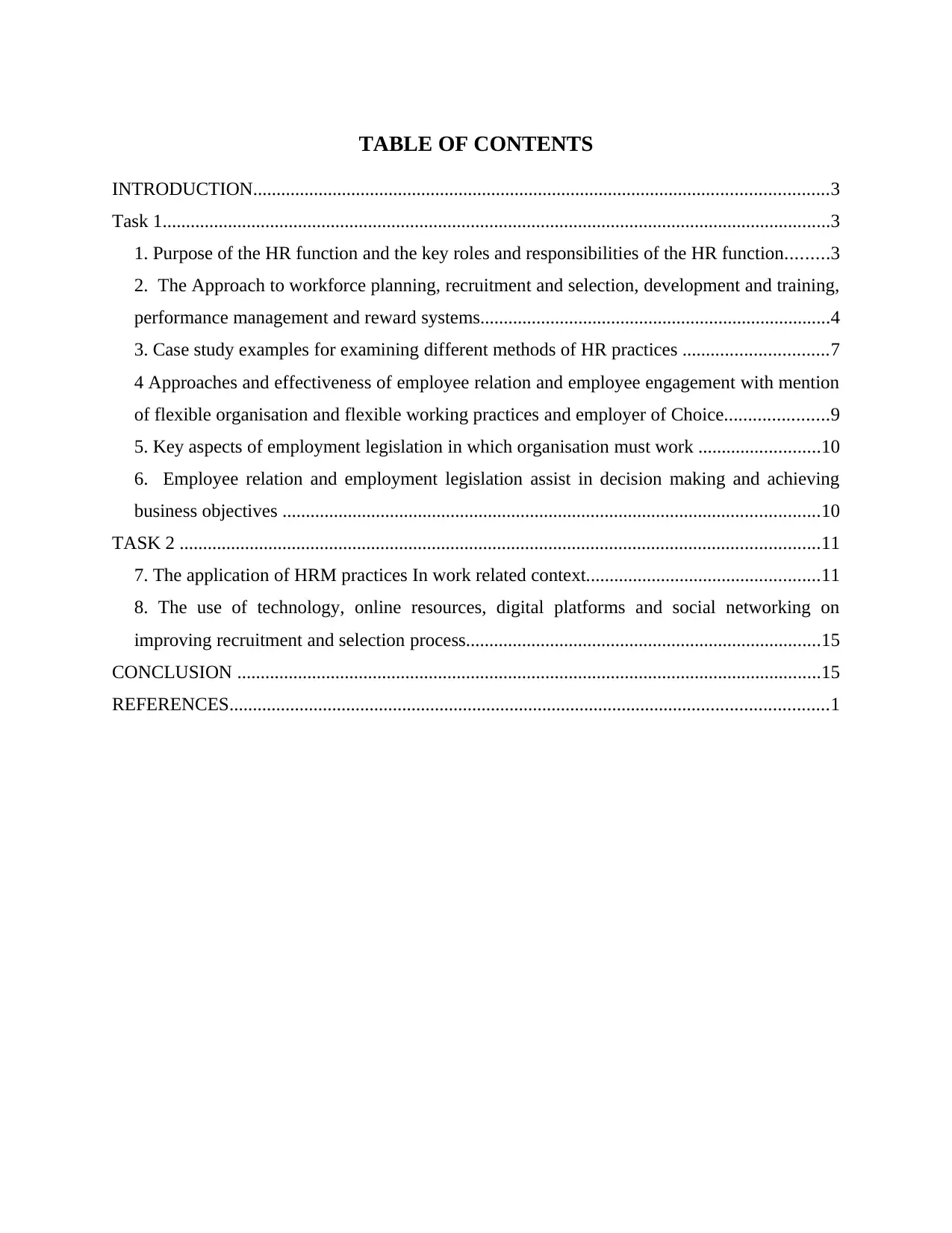
TABLE OF CONTENTS
INTRODUCTION...........................................................................................................................3
Task 1...............................................................................................................................................3
1. Purpose of the HR function and the key roles and responsibilities of the HR function.........3
2. The Approach to workforce planning, recruitment and selection, development and training,
performance management and reward systems...........................................................................4
3. Case study examples for examining different methods of HR practices ...............................7
4 Approaches and effectiveness of employee relation and employee engagement with mention
of flexible organisation and flexible working practices and employer of Choice......................9
5. Key aspects of employment legislation in which organisation must work ..........................10
6. Employee relation and employment legislation assist in decision making and achieving
business objectives ...................................................................................................................10
TASK 2 .........................................................................................................................................11
7. The application of HRM practices In work related context..................................................11
8. The use of technology, online resources, digital platforms and social networking on
improving recruitment and selection process............................................................................15
CONCLUSION .............................................................................................................................15
REFERENCES................................................................................................................................1
INTRODUCTION...........................................................................................................................3
Task 1...............................................................................................................................................3
1. Purpose of the HR function and the key roles and responsibilities of the HR function.........3
2. The Approach to workforce planning, recruitment and selection, development and training,
performance management and reward systems...........................................................................4
3. Case study examples for examining different methods of HR practices ...............................7
4 Approaches and effectiveness of employee relation and employee engagement with mention
of flexible organisation and flexible working practices and employer of Choice......................9
5. Key aspects of employment legislation in which organisation must work ..........................10
6. Employee relation and employment legislation assist in decision making and achieving
business objectives ...................................................................................................................10
TASK 2 .........................................................................................................................................11
7. The application of HRM practices In work related context..................................................11
8. The use of technology, online resources, digital platforms and social networking on
improving recruitment and selection process............................................................................15
CONCLUSION .............................................................................................................................15
REFERENCES................................................................................................................................1
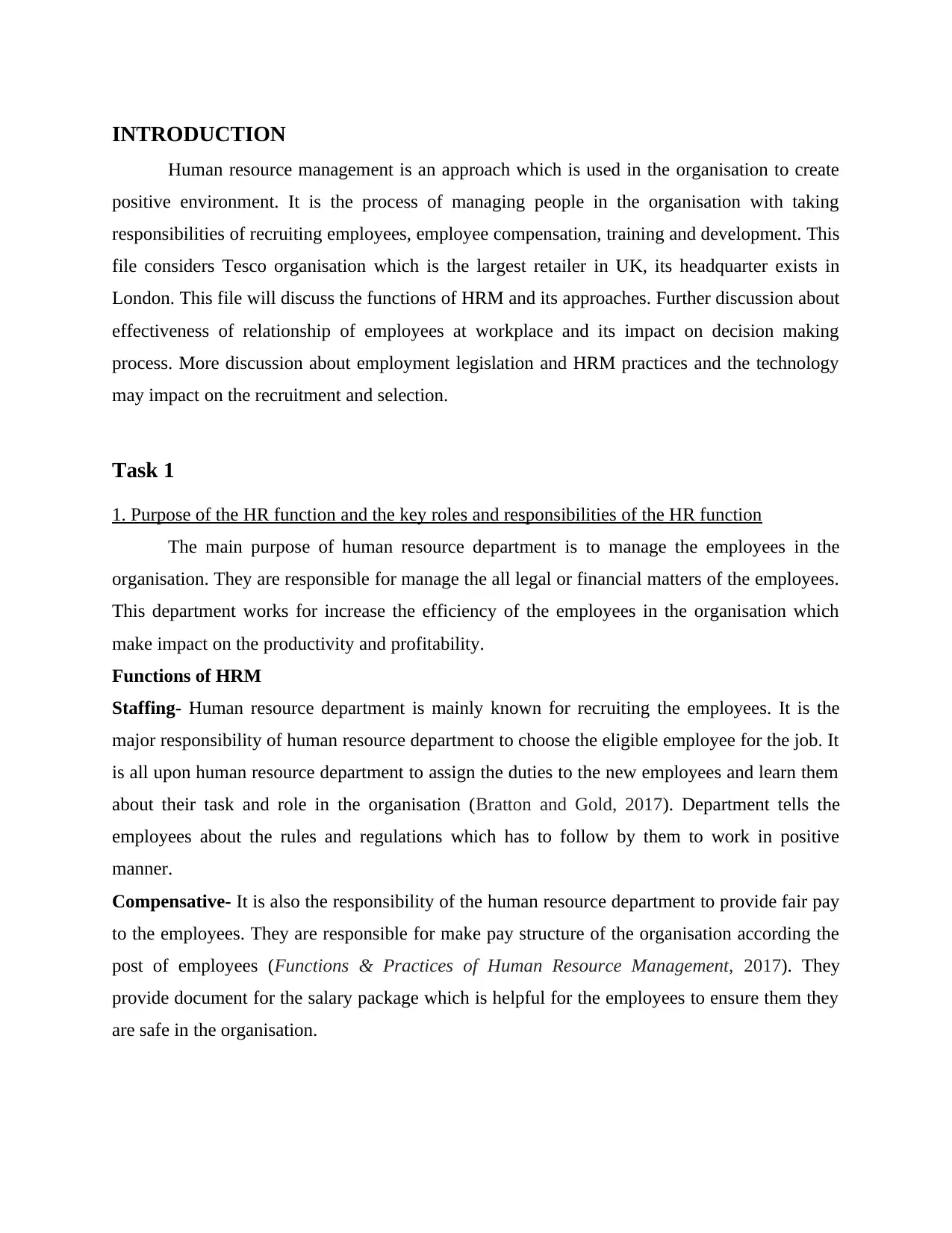
INTRODUCTION
Human resource management is an approach which is used in the organisation to create
positive environment. It is the process of managing people in the organisation with taking
responsibilities of recruiting employees, employee compensation, training and development. This
file considers Tesco organisation which is the largest retailer in UK, its headquarter exists in
London. This file will discuss the functions of HRM and its approaches. Further discussion about
effectiveness of relationship of employees at workplace and its impact on decision making
process. More discussion about employment legislation and HRM practices and the technology
may impact on the recruitment and selection.
Task 1
1. Purpose of the HR function and the key roles and responsibilities of the HR function
The main purpose of human resource department is to manage the employees in the
organisation. They are responsible for manage the all legal or financial matters of the employees.
This department works for increase the efficiency of the employees in the organisation which
make impact on the productivity and profitability.
Functions of HRM
Staffing- Human resource department is mainly known for recruiting the employees. It is the
major responsibility of human resource department to choose the eligible employee for the job. It
is all upon human resource department to assign the duties to the new employees and learn them
about their task and role in the organisation (Bratton and Gold, 2017). Department tells the
employees about the rules and regulations which has to follow by them to work in positive
manner.
Compensative- It is also the responsibility of the human resource department to provide fair pay
to the employees. They are responsible for make pay structure of the organisation according the
post of employees (Functions & Practices of Human Resource Management, 2017). They
provide document for the salary package which is helpful for the employees to ensure them they
are safe in the organisation.
Human resource management is an approach which is used in the organisation to create
positive environment. It is the process of managing people in the organisation with taking
responsibilities of recruiting employees, employee compensation, training and development. This
file considers Tesco organisation which is the largest retailer in UK, its headquarter exists in
London. This file will discuss the functions of HRM and its approaches. Further discussion about
effectiveness of relationship of employees at workplace and its impact on decision making
process. More discussion about employment legislation and HRM practices and the technology
may impact on the recruitment and selection.
Task 1
1. Purpose of the HR function and the key roles and responsibilities of the HR function
The main purpose of human resource department is to manage the employees in the
organisation. They are responsible for manage the all legal or financial matters of the employees.
This department works for increase the efficiency of the employees in the organisation which
make impact on the productivity and profitability.
Functions of HRM
Staffing- Human resource department is mainly known for recruiting the employees. It is the
major responsibility of human resource department to choose the eligible employee for the job. It
is all upon human resource department to assign the duties to the new employees and learn them
about their task and role in the organisation (Bratton and Gold, 2017). Department tells the
employees about the rules and regulations which has to follow by them to work in positive
manner.
Compensative- It is also the responsibility of the human resource department to provide fair pay
to the employees. They are responsible for make pay structure of the organisation according the
post of employees (Functions & Practices of Human Resource Management, 2017). They
provide document for the salary package which is helpful for the employees to ensure them they
are safe in the organisation.
⊘ This is a preview!⊘
Do you want full access?
Subscribe today to unlock all pages.

Trusted by 1+ million students worldwide
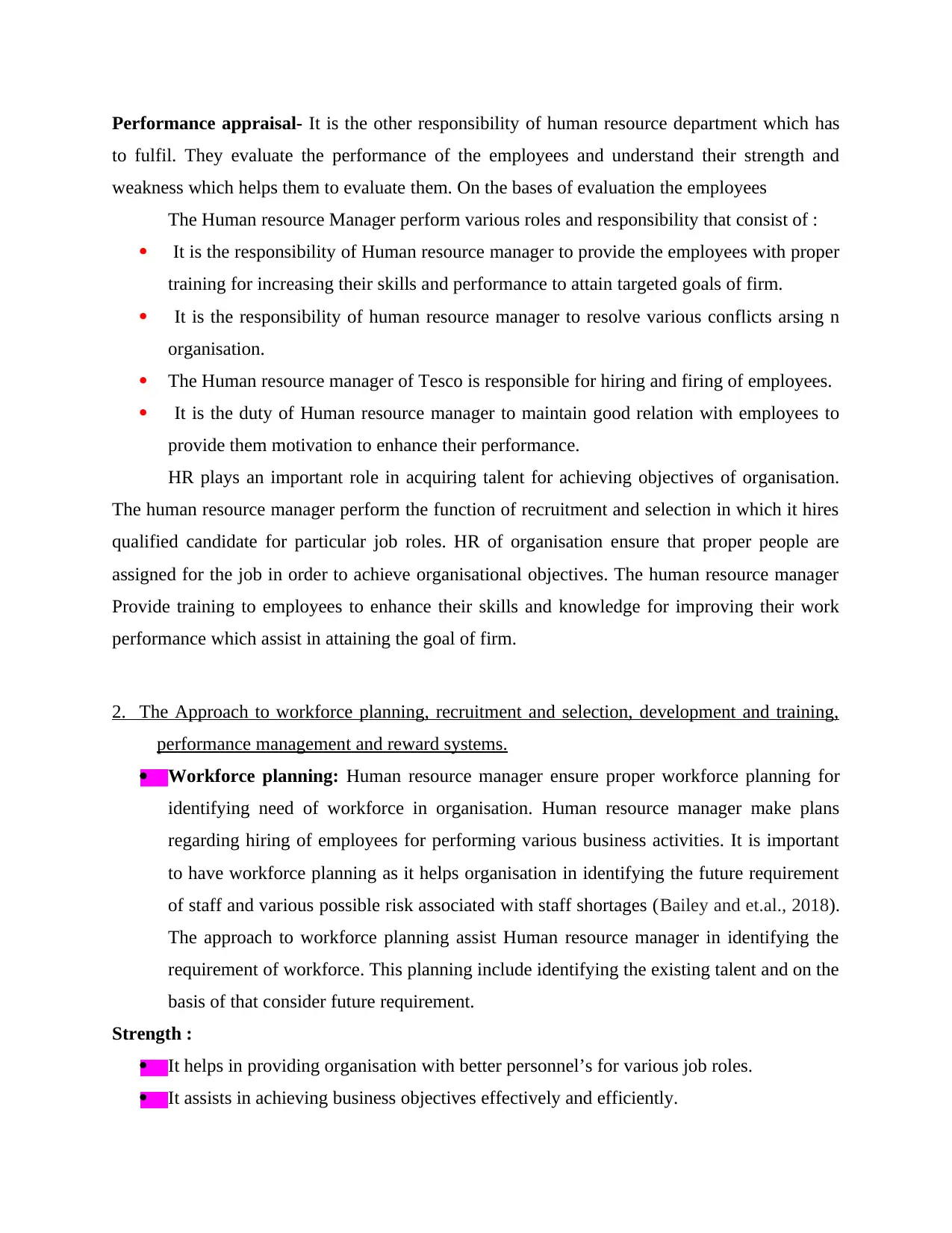
Performance appraisal- It is the other responsibility of human resource department which has
to fulfil. They evaluate the performance of the employees and understand their strength and
weakness which helps them to evaluate them. On the bases of evaluation the employees
The Human resource Manager perform various roles and responsibility that consist of :
It is the responsibility of Human resource manager to provide the employees with proper
training for increasing their skills and performance to attain targeted goals of firm.
It is the responsibility of human resource manager to resolve various conflicts arsing n
organisation.
The Human resource manager of Tesco is responsible for hiring and firing of employees.
It is the duty of Human resource manager to maintain good relation with employees to
provide them motivation to enhance their performance.
HR plays an important role in acquiring talent for achieving objectives of organisation.
The human resource manager perform the function of recruitment and selection in which it hires
qualified candidate for particular job roles. HR of organisation ensure that proper people are
assigned for the job in order to achieve organisational objectives. The human resource manager
Provide training to employees to enhance their skills and knowledge for improving their work
performance which assist in attaining the goal of firm.
2. The Approach to workforce planning, recruitment and selection, development and training,
performance management and reward systems.
Workforce planning: Human resource manager ensure proper workforce planning for
identifying need of workforce in organisation. Human resource manager make plans
regarding hiring of employees for performing various business activities. It is important
to have workforce planning as it helps organisation in identifying the future requirement
of staff and various possible risk associated with staff shortages (Bailey and et.al., 2018).
The approach to workforce planning assist Human resource manager in identifying the
requirement of workforce. This planning include identifying the existing talent and on the
basis of that consider future requirement.
Strength :
It helps in providing organisation with better personnel’s for various job roles.
It assists in achieving business objectives effectively and efficiently.
to fulfil. They evaluate the performance of the employees and understand their strength and
weakness which helps them to evaluate them. On the bases of evaluation the employees
The Human resource Manager perform various roles and responsibility that consist of :
It is the responsibility of Human resource manager to provide the employees with proper
training for increasing their skills and performance to attain targeted goals of firm.
It is the responsibility of human resource manager to resolve various conflicts arsing n
organisation.
The Human resource manager of Tesco is responsible for hiring and firing of employees.
It is the duty of Human resource manager to maintain good relation with employees to
provide them motivation to enhance their performance.
HR plays an important role in acquiring talent for achieving objectives of organisation.
The human resource manager perform the function of recruitment and selection in which it hires
qualified candidate for particular job roles. HR of organisation ensure that proper people are
assigned for the job in order to achieve organisational objectives. The human resource manager
Provide training to employees to enhance their skills and knowledge for improving their work
performance which assist in attaining the goal of firm.
2. The Approach to workforce planning, recruitment and selection, development and training,
performance management and reward systems.
Workforce planning: Human resource manager ensure proper workforce planning for
identifying need of workforce in organisation. Human resource manager make plans
regarding hiring of employees for performing various business activities. It is important
to have workforce planning as it helps organisation in identifying the future requirement
of staff and various possible risk associated with staff shortages (Bailey and et.al., 2018).
The approach to workforce planning assist Human resource manager in identifying the
requirement of workforce. This planning include identifying the existing talent and on the
basis of that consider future requirement.
Strength :
It helps in providing organisation with better personnel’s for various job roles.
It assists in achieving business objectives effectively and efficiently.
Paraphrase This Document
Need a fresh take? Get an instant paraphrase of this document with our AI Paraphraser
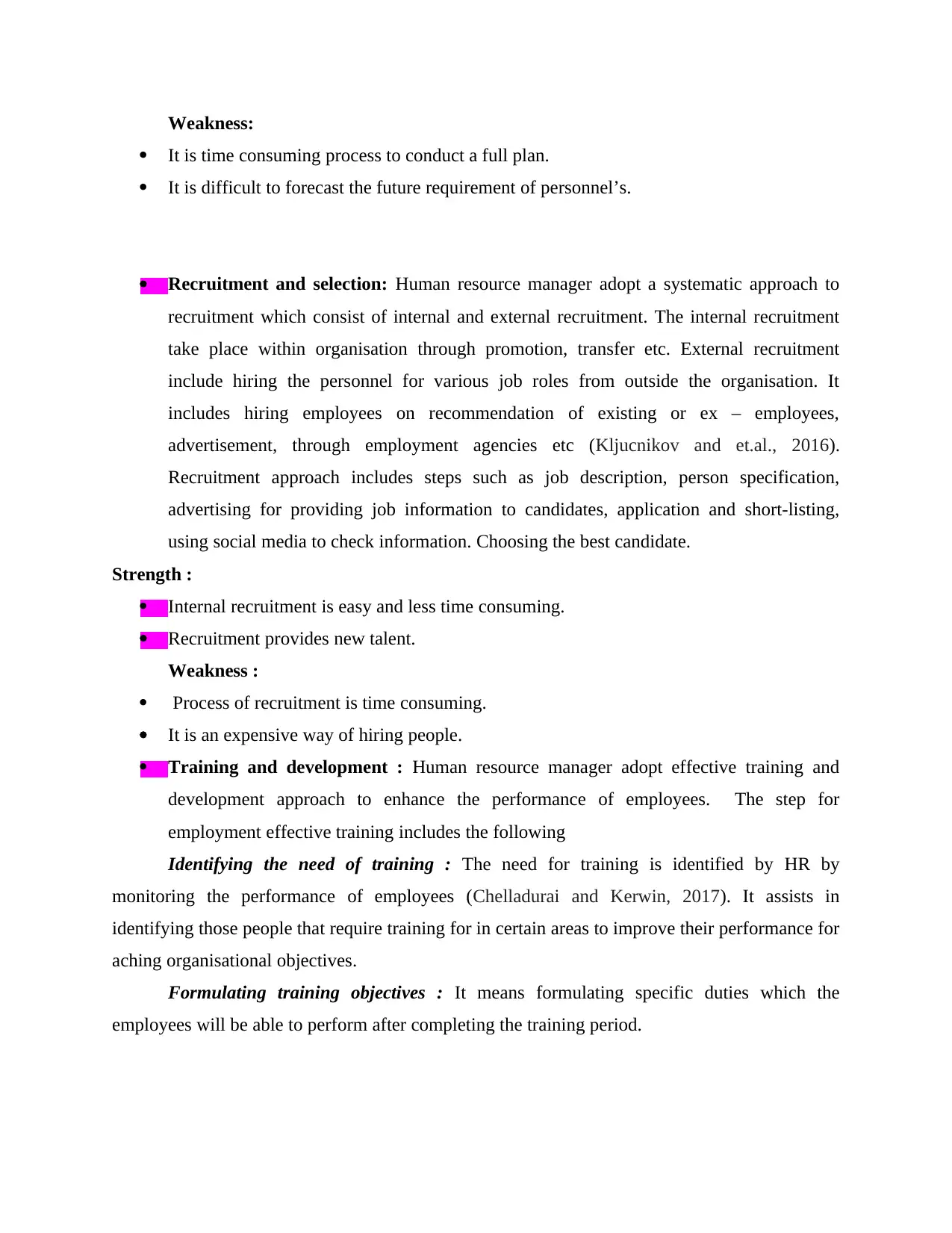
Weakness:
It is time consuming process to conduct a full plan.
It is difficult to forecast the future requirement of personnel’s.
Recruitment and selection: Human resource manager adopt a systematic approach to
recruitment which consist of internal and external recruitment. The internal recruitment
take place within organisation through promotion, transfer etc. External recruitment
include hiring the personnel for various job roles from outside the organisation. It
includes hiring employees on recommendation of existing or ex – employees,
advertisement, through employment agencies etc (Kljucnikov and et.al., 2016).
Recruitment approach includes steps such as job description, person specification,
advertising for providing job information to candidates, application and short-listing,
using social media to check information. Choosing the best candidate.
Strength :
Internal recruitment is easy and less time consuming.
Recruitment provides new talent.
Weakness :
Process of recruitment is time consuming.
It is an expensive way of hiring people.
Training and development : Human resource manager adopt effective training and
development approach to enhance the performance of employees. The step for
employment effective training includes the following
Identifying the need of training : The need for training is identified by HR by
monitoring the performance of employees (Chelladurai and Kerwin, 2017). It assists in
identifying those people that require training for in certain areas to improve their performance for
aching organisational objectives.
Formulating training objectives : It means formulating specific duties which the
employees will be able to perform after completing the training period.
It is time consuming process to conduct a full plan.
It is difficult to forecast the future requirement of personnel’s.
Recruitment and selection: Human resource manager adopt a systematic approach to
recruitment which consist of internal and external recruitment. The internal recruitment
take place within organisation through promotion, transfer etc. External recruitment
include hiring the personnel for various job roles from outside the organisation. It
includes hiring employees on recommendation of existing or ex – employees,
advertisement, through employment agencies etc (Kljucnikov and et.al., 2016).
Recruitment approach includes steps such as job description, person specification,
advertising for providing job information to candidates, application and short-listing,
using social media to check information. Choosing the best candidate.
Strength :
Internal recruitment is easy and less time consuming.
Recruitment provides new talent.
Weakness :
Process of recruitment is time consuming.
It is an expensive way of hiring people.
Training and development : Human resource manager adopt effective training and
development approach to enhance the performance of employees. The step for
employment effective training includes the following
Identifying the need of training : The need for training is identified by HR by
monitoring the performance of employees (Chelladurai and Kerwin, 2017). It assists in
identifying those people that require training for in certain areas to improve their performance for
aching organisational objectives.
Formulating training objectives : It means formulating specific duties which the
employees will be able to perform after completing the training period.
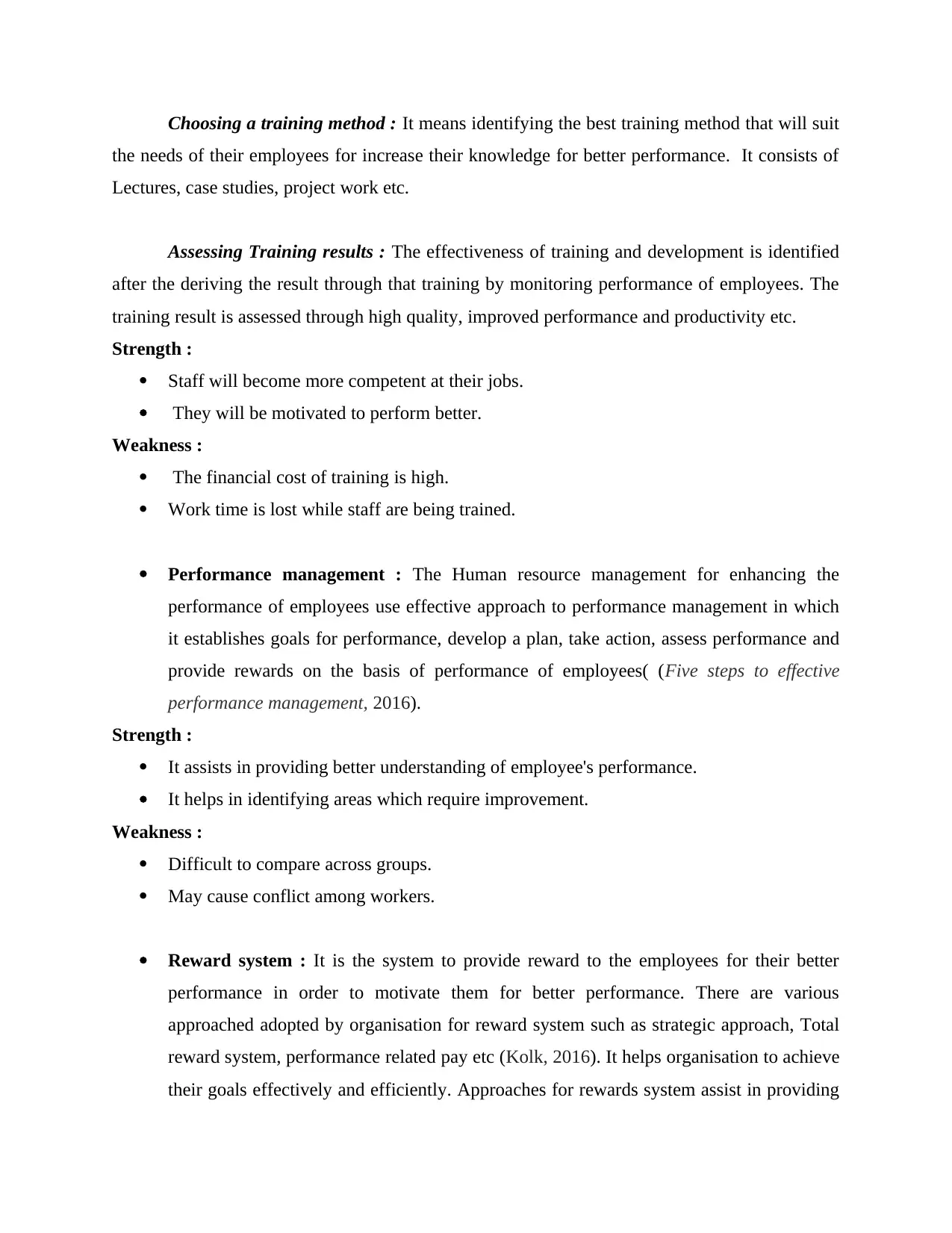
Choosing a training method : It means identifying the best training method that will suit
the needs of their employees for increase their knowledge for better performance. It consists of
Lectures, case studies, project work etc.
Assessing Training results : The effectiveness of training and development is identified
after the deriving the result through that training by monitoring performance of employees. The
training result is assessed through high quality, improved performance and productivity etc.
Strength :
Staff will become more competent at their jobs.
They will be motivated to perform better.
Weakness :
The financial cost of training is high.
Work time is lost while staff are being trained.
Performance management : The Human resource management for enhancing the
performance of employees use effective approach to performance management in which
it establishes goals for performance, develop a plan, take action, assess performance and
provide rewards on the basis of performance of employees( (Five steps to effective
performance management, 2016).
Strength :
It assists in providing better understanding of employee's performance.
It helps in identifying areas which require improvement.
Weakness :
Difficult to compare across groups.
May cause conflict among workers.
Reward system : It is the system to provide reward to the employees for their better
performance in order to motivate them for better performance. There are various
approached adopted by organisation for reward system such as strategic approach, Total
reward system, performance related pay etc (Kolk, 2016). It helps organisation to achieve
their goals effectively and efficiently. Approaches for rewards system assist in providing
the needs of their employees for increase their knowledge for better performance. It consists of
Lectures, case studies, project work etc.
Assessing Training results : The effectiveness of training and development is identified
after the deriving the result through that training by monitoring performance of employees. The
training result is assessed through high quality, improved performance and productivity etc.
Strength :
Staff will become more competent at their jobs.
They will be motivated to perform better.
Weakness :
The financial cost of training is high.
Work time is lost while staff are being trained.
Performance management : The Human resource management for enhancing the
performance of employees use effective approach to performance management in which
it establishes goals for performance, develop a plan, take action, assess performance and
provide rewards on the basis of performance of employees( (Five steps to effective
performance management, 2016).
Strength :
It assists in providing better understanding of employee's performance.
It helps in identifying areas which require improvement.
Weakness :
Difficult to compare across groups.
May cause conflict among workers.
Reward system : It is the system to provide reward to the employees for their better
performance in order to motivate them for better performance. There are various
approached adopted by organisation for reward system such as strategic approach, Total
reward system, performance related pay etc (Kolk, 2016). It helps organisation to achieve
their goals effectively and efficiently. Approaches for rewards system assist in providing
⊘ This is a preview!⊘
Do you want full access?
Subscribe today to unlock all pages.

Trusted by 1+ million students worldwide
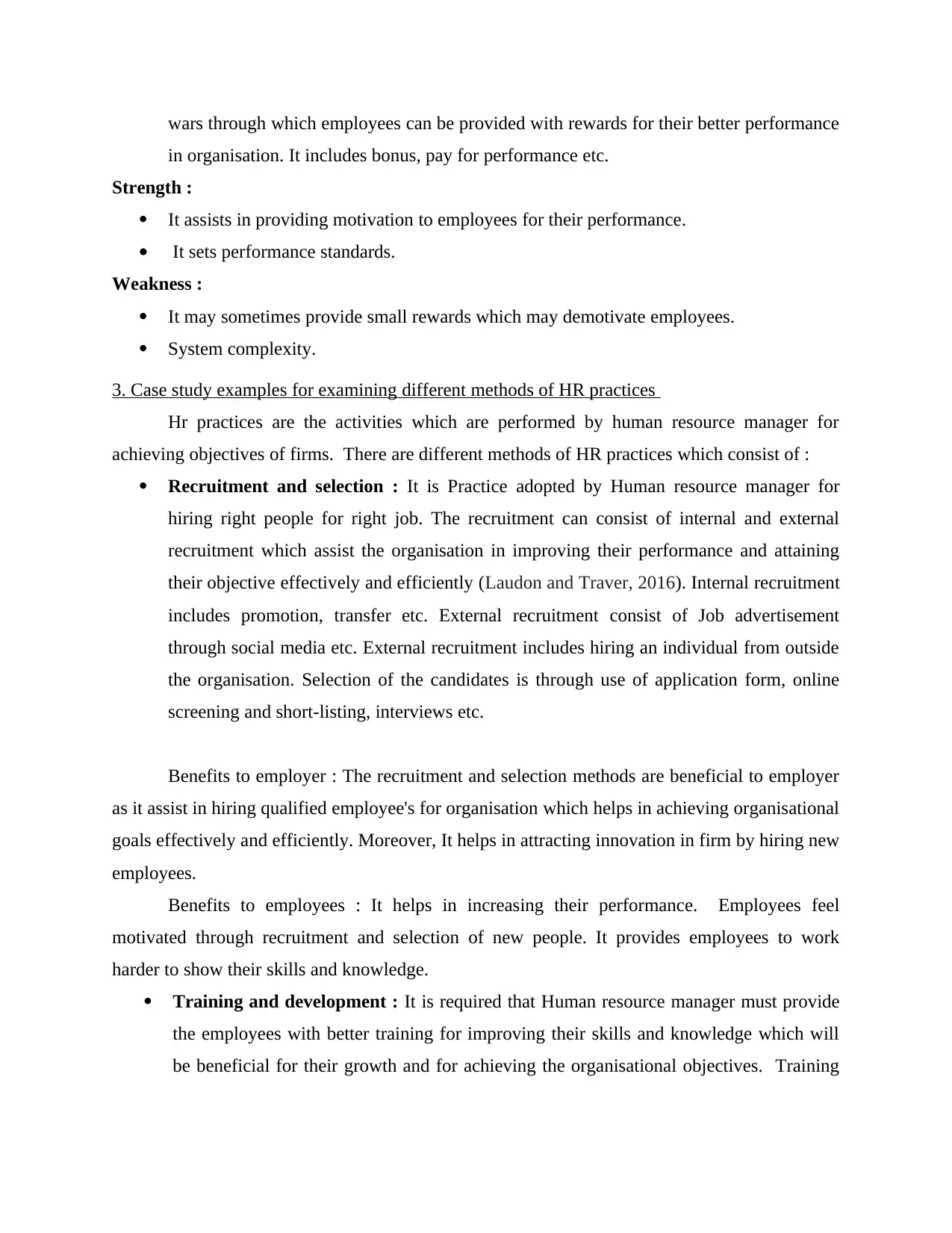
wars through which employees can be provided with rewards for their better performance
in organisation. It includes bonus, pay for performance etc.
Strength :
It assists in providing motivation to employees for their performance.
It sets performance standards.
Weakness :
It may sometimes provide small rewards which may demotivate employees.
System complexity.
3. Case study examples for examining different methods of HR practices
Hr practices are the activities which are performed by human resource manager for
achieving objectives of firms. There are different methods of HR practices which consist of :
Recruitment and selection : It is Practice adopted by Human resource manager for
hiring right people for right job. The recruitment can consist of internal and external
recruitment which assist the organisation in improving their performance and attaining
their objective effectively and efficiently (Laudon and Traver, 2016). Internal recruitment
includes promotion, transfer etc. External recruitment consist of Job advertisement
through social media etc. External recruitment includes hiring an individual from outside
the organisation. Selection of the candidates is through use of application form, online
screening and short-listing, interviews etc.
Benefits to employer : The recruitment and selection methods are beneficial to employer
as it assist in hiring qualified employee's for organisation which helps in achieving organisational
goals effectively and efficiently. Moreover, It helps in attracting innovation in firm by hiring new
employees.
Benefits to employees : It helps in increasing their performance. Employees feel
motivated through recruitment and selection of new people. It provides employees to work
harder to show their skills and knowledge.
Training and development : It is required that Human resource manager must provide
the employees with better training for improving their skills and knowledge which will
be beneficial for their growth and for achieving the organisational objectives. Training
in organisation. It includes bonus, pay for performance etc.
Strength :
It assists in providing motivation to employees for their performance.
It sets performance standards.
Weakness :
It may sometimes provide small rewards which may demotivate employees.
System complexity.
3. Case study examples for examining different methods of HR practices
Hr practices are the activities which are performed by human resource manager for
achieving objectives of firms. There are different methods of HR practices which consist of :
Recruitment and selection : It is Practice adopted by Human resource manager for
hiring right people for right job. The recruitment can consist of internal and external
recruitment which assist the organisation in improving their performance and attaining
their objective effectively and efficiently (Laudon and Traver, 2016). Internal recruitment
includes promotion, transfer etc. External recruitment consist of Job advertisement
through social media etc. External recruitment includes hiring an individual from outside
the organisation. Selection of the candidates is through use of application form, online
screening and short-listing, interviews etc.
Benefits to employer : The recruitment and selection methods are beneficial to employer
as it assist in hiring qualified employee's for organisation which helps in achieving organisational
goals effectively and efficiently. Moreover, It helps in attracting innovation in firm by hiring new
employees.
Benefits to employees : It helps in increasing their performance. Employees feel
motivated through recruitment and selection of new people. It provides employees to work
harder to show their skills and knowledge.
Training and development : It is required that Human resource manager must provide
the employees with better training for improving their skills and knowledge which will
be beneficial for their growth and for achieving the organisational objectives. Training
Paraphrase This Document
Need a fresh take? Get an instant paraphrase of this document with our AI Paraphraser
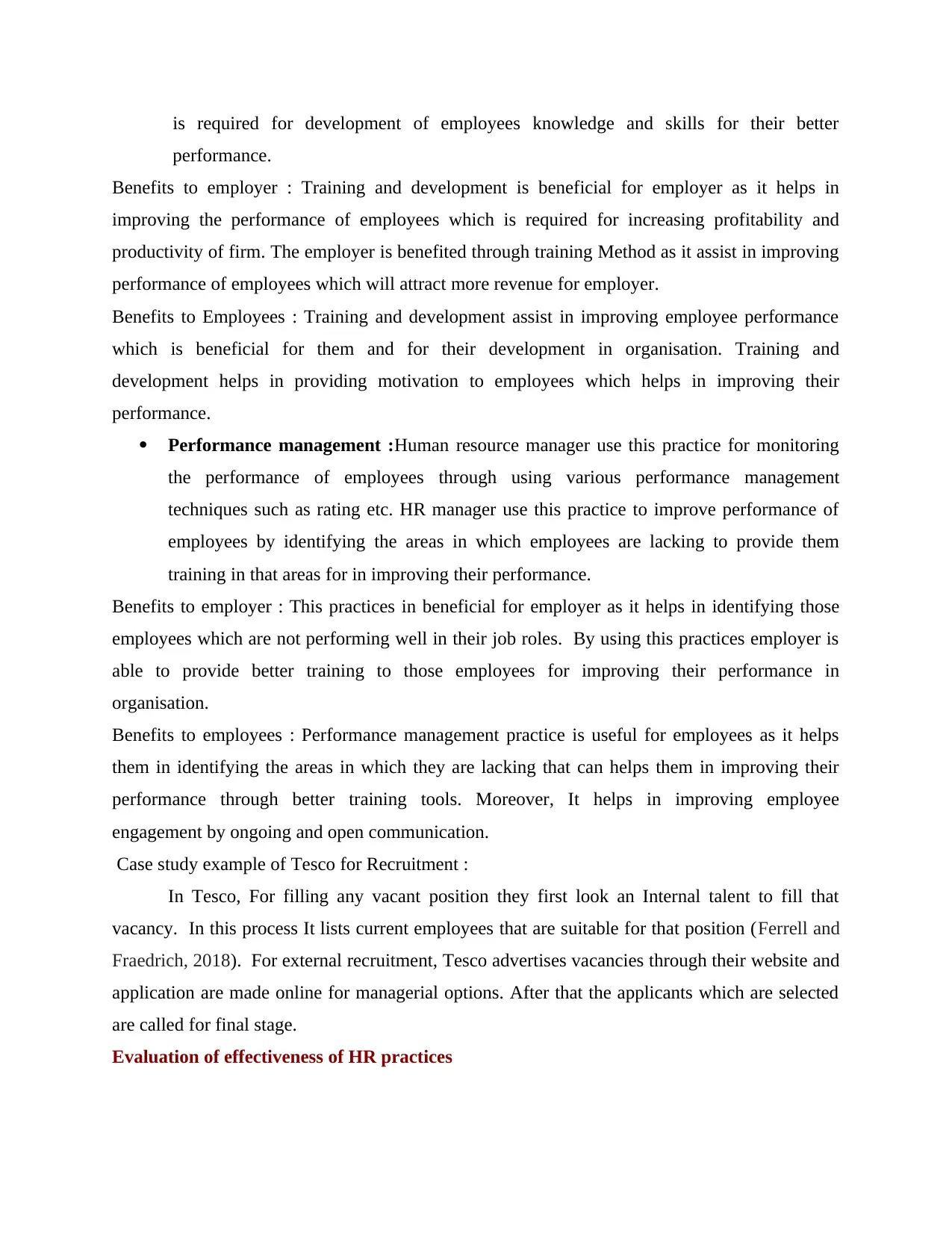
is required for development of employees knowledge and skills for their better
performance.
Benefits to employer : Training and development is beneficial for employer as it helps in
improving the performance of employees which is required for increasing profitability and
productivity of firm. The employer is benefited through training Method as it assist in improving
performance of employees which will attract more revenue for employer.
Benefits to Employees : Training and development assist in improving employee performance
which is beneficial for them and for their development in organisation. Training and
development helps in providing motivation to employees which helps in improving their
performance.
Performance management :Human resource manager use this practice for monitoring
the performance of employees through using various performance management
techniques such as rating etc. HR manager use this practice to improve performance of
employees by identifying the areas in which employees are lacking to provide them
training in that areas for in improving their performance.
Benefits to employer : This practices in beneficial for employer as it helps in identifying those
employees which are not performing well in their job roles. By using this practices employer is
able to provide better training to those employees for improving their performance in
organisation.
Benefits to employees : Performance management practice is useful for employees as it helps
them in identifying the areas in which they are lacking that can helps them in improving their
performance through better training tools. Moreover, It helps in improving employee
engagement by ongoing and open communication.
Case study example of Tesco for Recruitment :
In Tesco, For filling any vacant position they first look an Internal talent to fill that
vacancy. In this process It lists current employees that are suitable for that position (Ferrell and
Fraedrich, 2018). For external recruitment, Tesco advertises vacancies through their website and
application are made online for managerial options. After that the applicants which are selected
are called for final stage.
Evaluation of effectiveness of HR practices
performance.
Benefits to employer : Training and development is beneficial for employer as it helps in
improving the performance of employees which is required for increasing profitability and
productivity of firm. The employer is benefited through training Method as it assist in improving
performance of employees which will attract more revenue for employer.
Benefits to Employees : Training and development assist in improving employee performance
which is beneficial for them and for their development in organisation. Training and
development helps in providing motivation to employees which helps in improving their
performance.
Performance management :Human resource manager use this practice for monitoring
the performance of employees through using various performance management
techniques such as rating etc. HR manager use this practice to improve performance of
employees by identifying the areas in which employees are lacking to provide them
training in that areas for in improving their performance.
Benefits to employer : This practices in beneficial for employer as it helps in identifying those
employees which are not performing well in their job roles. By using this practices employer is
able to provide better training to those employees for improving their performance in
organisation.
Benefits to employees : Performance management practice is useful for employees as it helps
them in identifying the areas in which they are lacking that can helps them in improving their
performance through better training tools. Moreover, It helps in improving employee
engagement by ongoing and open communication.
Case study example of Tesco for Recruitment :
In Tesco, For filling any vacant position they first look an Internal talent to fill that
vacancy. In this process It lists current employees that are suitable for that position (Ferrell and
Fraedrich, 2018). For external recruitment, Tesco advertises vacancies through their website and
application are made online for managerial options. After that the applicants which are selected
are called for final stage.
Evaluation of effectiveness of HR practices
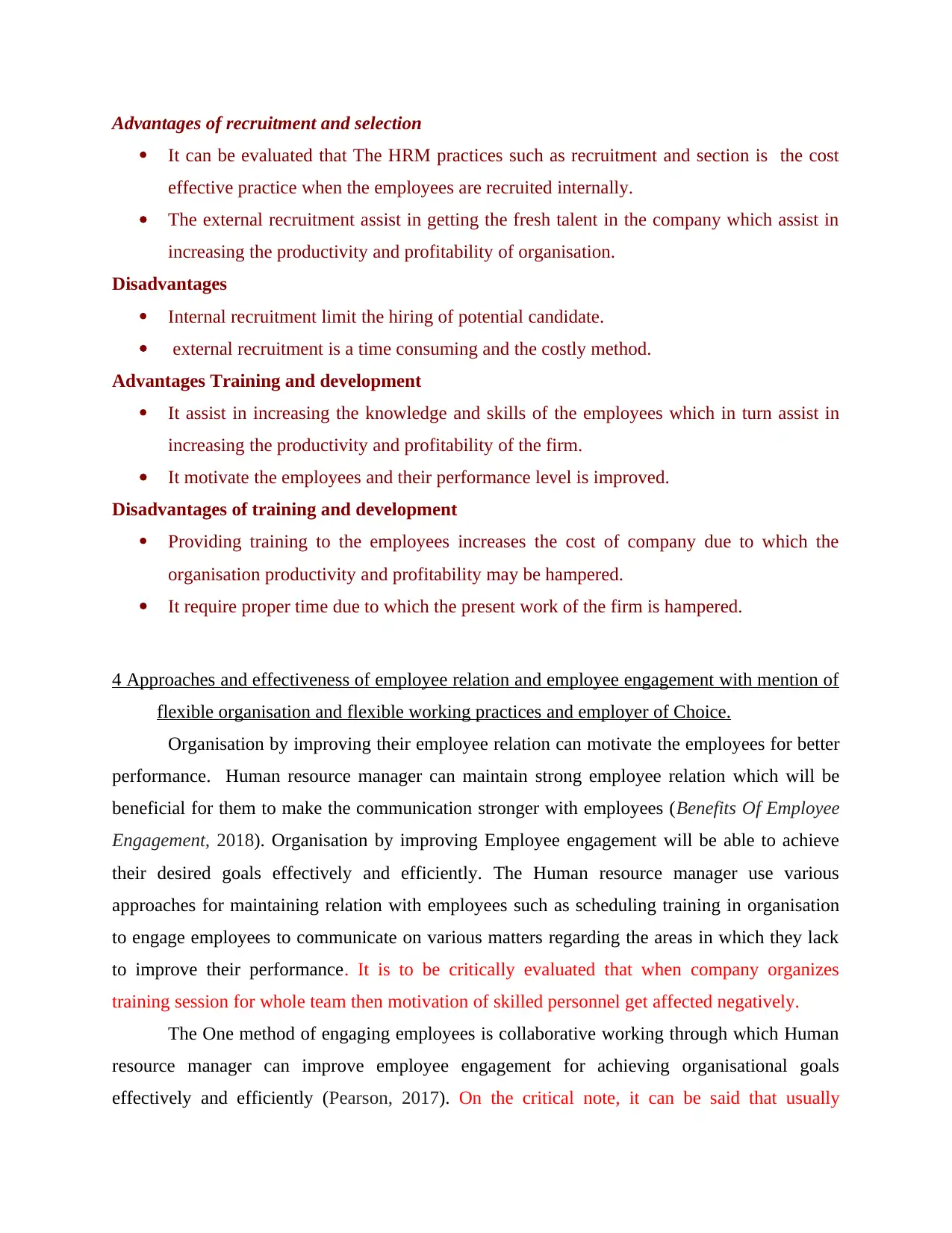
Advantages of recruitment and selection
It can be evaluated that The HRM practices such as recruitment and section is the cost
effective practice when the employees are recruited internally.
The external recruitment assist in getting the fresh talent in the company which assist in
increasing the productivity and profitability of organisation.
Disadvantages
Internal recruitment limit the hiring of potential candidate.
external recruitment is a time consuming and the costly method.
Advantages Training and development
It assist in increasing the knowledge and skills of the employees which in turn assist in
increasing the productivity and profitability of the firm.
It motivate the employees and their performance level is improved.
Disadvantages of training and development
Providing training to the employees increases the cost of company due to which the
organisation productivity and profitability may be hampered.
It require proper time due to which the present work of the firm is hampered.
4 Approaches and effectiveness of employee relation and employee engagement with mention of
flexible organisation and flexible working practices and employer of Choice.
Organisation by improving their employee relation can motivate the employees for better
performance. Human resource manager can maintain strong employee relation which will be
beneficial for them to make the communication stronger with employees (Benefits Of Employee
Engagement, 2018). Organisation by improving Employee engagement will be able to achieve
their desired goals effectively and efficiently. The Human resource manager use various
approaches for maintaining relation with employees such as scheduling training in organisation
to engage employees to communicate on various matters regarding the areas in which they lack
to improve their performance. It is to be critically evaluated that when company organizes
training session for whole team then motivation of skilled personnel get affected negatively.
The One method of engaging employees is collaborative working through which Human
resource manager can improve employee engagement for achieving organisational goals
effectively and efficiently (Pearson, 2017). On the critical note, it can be said that usually
It can be evaluated that The HRM practices such as recruitment and section is the cost
effective practice when the employees are recruited internally.
The external recruitment assist in getting the fresh talent in the company which assist in
increasing the productivity and profitability of organisation.
Disadvantages
Internal recruitment limit the hiring of potential candidate.
external recruitment is a time consuming and the costly method.
Advantages Training and development
It assist in increasing the knowledge and skills of the employees which in turn assist in
increasing the productivity and profitability of the firm.
It motivate the employees and their performance level is improved.
Disadvantages of training and development
Providing training to the employees increases the cost of company due to which the
organisation productivity and profitability may be hampered.
It require proper time due to which the present work of the firm is hampered.
4 Approaches and effectiveness of employee relation and employee engagement with mention of
flexible organisation and flexible working practices and employer of Choice.
Organisation by improving their employee relation can motivate the employees for better
performance. Human resource manager can maintain strong employee relation which will be
beneficial for them to make the communication stronger with employees (Benefits Of Employee
Engagement, 2018). Organisation by improving Employee engagement will be able to achieve
their desired goals effectively and efficiently. The Human resource manager use various
approaches for maintaining relation with employees such as scheduling training in organisation
to engage employees to communicate on various matters regarding the areas in which they lack
to improve their performance. It is to be critically evaluated that when company organizes
training session for whole team then motivation of skilled personnel get affected negatively.
The One method of engaging employees is collaborative working through which Human
resource manager can improve employee engagement for achieving organisational goals
effectively and efficiently (Pearson, 2017). On the critical note, it can be said that usually
⊘ This is a preview!⊘
Do you want full access?
Subscribe today to unlock all pages.

Trusted by 1+ million students worldwide
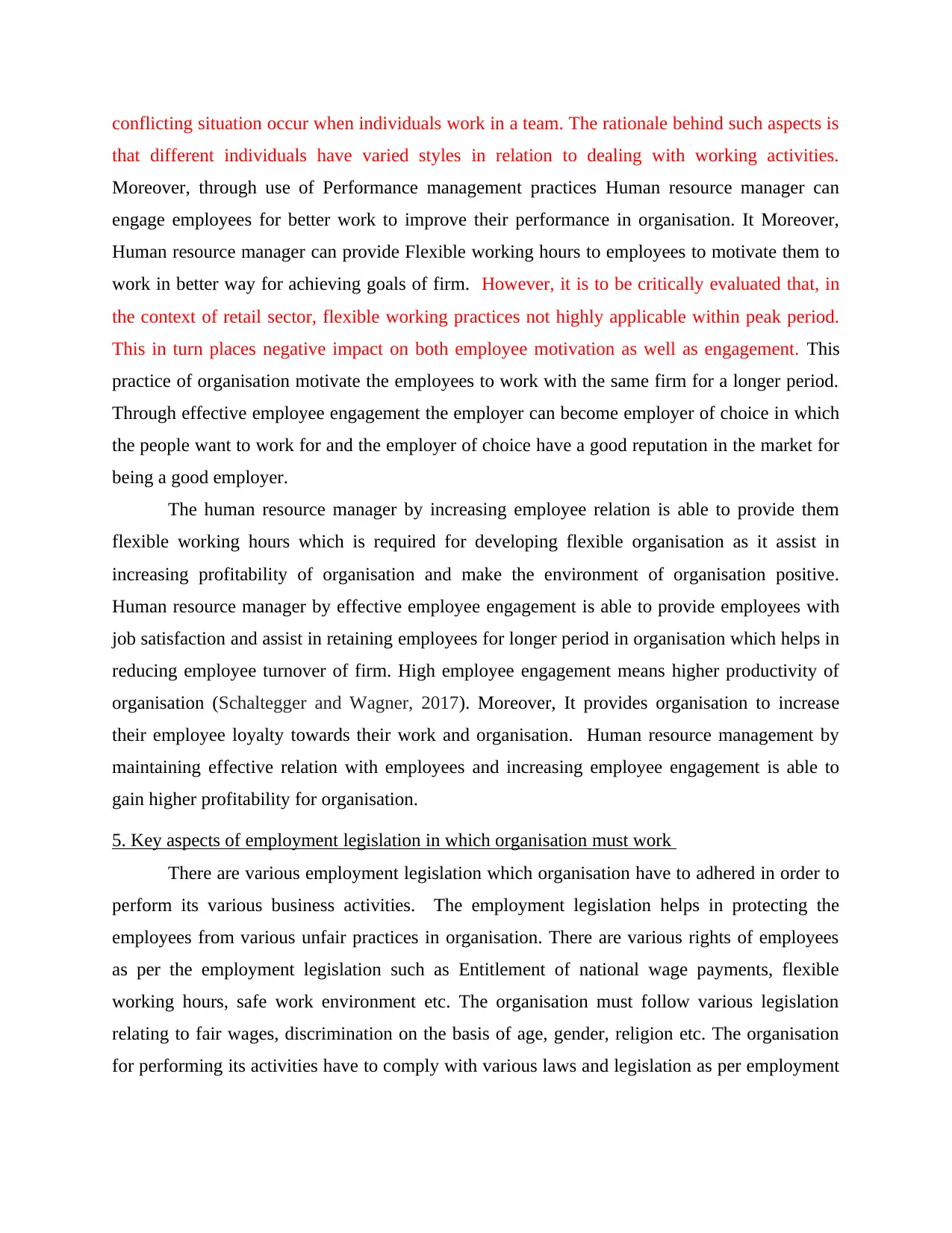
conflicting situation occur when individuals work in a team. The rationale behind such aspects is
that different individuals have varied styles in relation to dealing with working activities.
Moreover, through use of Performance management practices Human resource manager can
engage employees for better work to improve their performance in organisation. It Moreover,
Human resource manager can provide Flexible working hours to employees to motivate them to
work in better way for achieving goals of firm. However, it is to be critically evaluated that, in
the context of retail sector, flexible working practices not highly applicable within peak period.
This in turn places negative impact on both employee motivation as well as engagement. This
practice of organisation motivate the employees to work with the same firm for a longer period.
Through effective employee engagement the employer can become employer of choice in which
the people want to work for and the employer of choice have a good reputation in the market for
being a good employer.
The human resource manager by increasing employee relation is able to provide them
flexible working hours which is required for developing flexible organisation as it assist in
increasing profitability of organisation and make the environment of organisation positive.
Human resource manager by effective employee engagement is able to provide employees with
job satisfaction and assist in retaining employees for longer period in organisation which helps in
reducing employee turnover of firm. High employee engagement means higher productivity of
organisation (Schaltegger and Wagner, 2017). Moreover, It provides organisation to increase
their employee loyalty towards their work and organisation. Human resource management by
maintaining effective relation with employees and increasing employee engagement is able to
gain higher profitability for organisation.
5. Key aspects of employment legislation in which organisation must work
There are various employment legislation which organisation have to adhered in order to
perform its various business activities. The employment legislation helps in protecting the
employees from various unfair practices in organisation. There are various rights of employees
as per the employment legislation such as Entitlement of national wage payments, flexible
working hours, safe work environment etc. The organisation must follow various legislation
relating to fair wages, discrimination on the basis of age, gender, religion etc. The organisation
for performing its activities have to comply with various laws and legislation as per employment
that different individuals have varied styles in relation to dealing with working activities.
Moreover, through use of Performance management practices Human resource manager can
engage employees for better work to improve their performance in organisation. It Moreover,
Human resource manager can provide Flexible working hours to employees to motivate them to
work in better way for achieving goals of firm. However, it is to be critically evaluated that, in
the context of retail sector, flexible working practices not highly applicable within peak period.
This in turn places negative impact on both employee motivation as well as engagement. This
practice of organisation motivate the employees to work with the same firm for a longer period.
Through effective employee engagement the employer can become employer of choice in which
the people want to work for and the employer of choice have a good reputation in the market for
being a good employer.
The human resource manager by increasing employee relation is able to provide them
flexible working hours which is required for developing flexible organisation as it assist in
increasing profitability of organisation and make the environment of organisation positive.
Human resource manager by effective employee engagement is able to provide employees with
job satisfaction and assist in retaining employees for longer period in organisation which helps in
reducing employee turnover of firm. High employee engagement means higher productivity of
organisation (Schaltegger and Wagner, 2017). Moreover, It provides organisation to increase
their employee loyalty towards their work and organisation. Human resource management by
maintaining effective relation with employees and increasing employee engagement is able to
gain higher profitability for organisation.
5. Key aspects of employment legislation in which organisation must work
There are various employment legislation which organisation have to adhered in order to
perform its various business activities. The employment legislation helps in protecting the
employees from various unfair practices in organisation. There are various rights of employees
as per the employment legislation such as Entitlement of national wage payments, flexible
working hours, safe work environment etc. The organisation must follow various legislation
relating to fair wages, discrimination on the basis of age, gender, religion etc. The organisation
for performing its activities have to comply with various laws and legislation as per employment
Paraphrase This Document
Need a fresh take? Get an instant paraphrase of this document with our AI Paraphraser
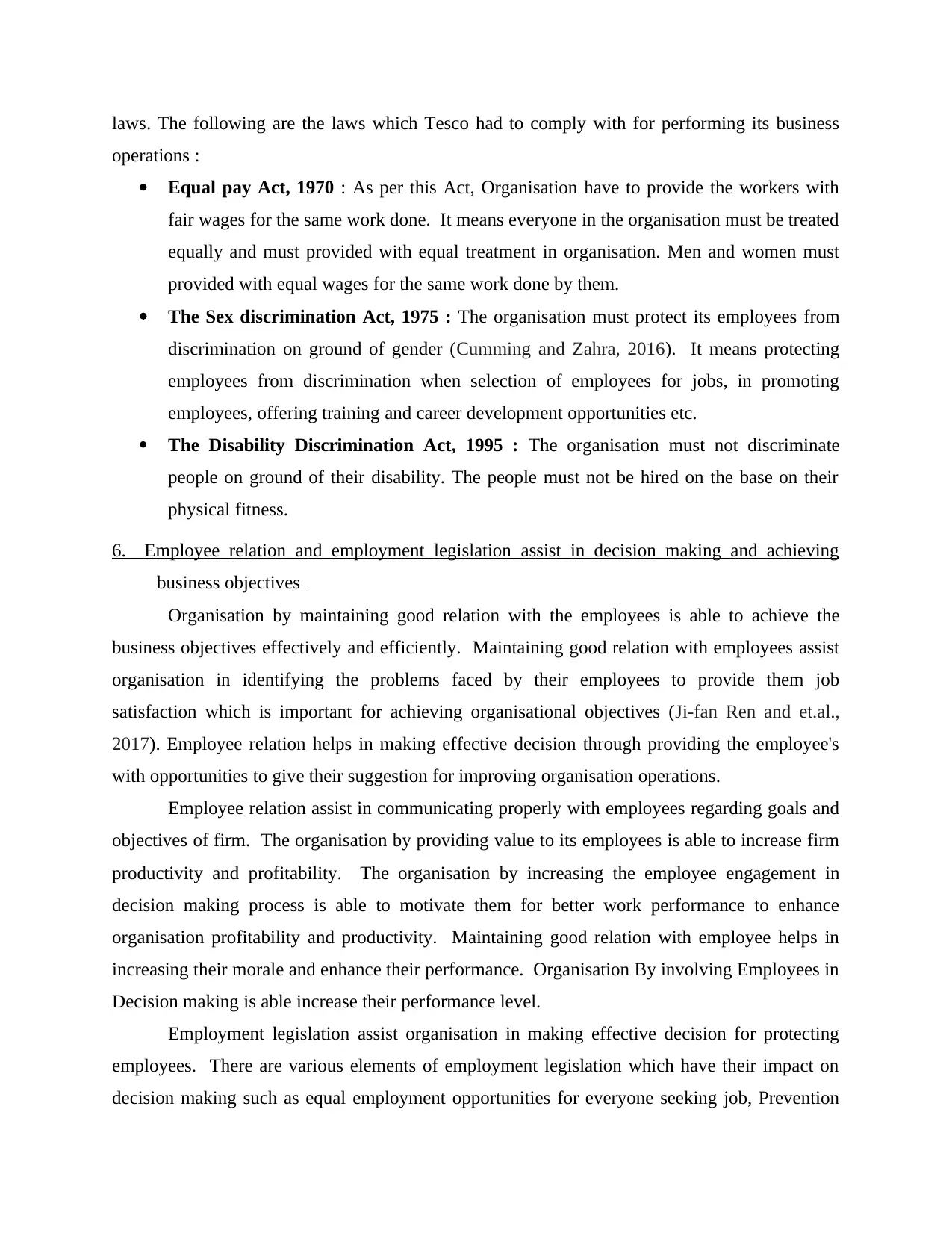
laws. The following are the laws which Tesco had to comply with for performing its business
operations :
Equal pay Act, 1970 : As per this Act, Organisation have to provide the workers with
fair wages for the same work done. It means everyone in the organisation must be treated
equally and must provided with equal treatment in organisation. Men and women must
provided with equal wages for the same work done by them.
The Sex discrimination Act, 1975 : The organisation must protect its employees from
discrimination on ground of gender (Cumming and Zahra, 2016). It means protecting
employees from discrimination when selection of employees for jobs, in promoting
employees, offering training and career development opportunities etc.
The Disability Discrimination Act, 1995 : The organisation must not discriminate
people on ground of their disability. The people must not be hired on the base on their
physical fitness.
6. Employee relation and employment legislation assist in decision making and achieving
business objectives
Organisation by maintaining good relation with the employees is able to achieve the
business objectives effectively and efficiently. Maintaining good relation with employees assist
organisation in identifying the problems faced by their employees to provide them job
satisfaction which is important for achieving organisational objectives (Ji-fan Ren and et.al.,
2017). Employee relation helps in making effective decision through providing the employee's
with opportunities to give their suggestion for improving organisation operations.
Employee relation assist in communicating properly with employees regarding goals and
objectives of firm. The organisation by providing value to its employees is able to increase firm
productivity and profitability. The organisation by increasing the employee engagement in
decision making process is able to motivate them for better work performance to enhance
organisation profitability and productivity. Maintaining good relation with employee helps in
increasing their morale and enhance their performance. Organisation By involving Employees in
Decision making is able increase their performance level.
Employment legislation assist organisation in making effective decision for protecting
employees. There are various elements of employment legislation which have their impact on
decision making such as equal employment opportunities for everyone seeking job, Prevention
operations :
Equal pay Act, 1970 : As per this Act, Organisation have to provide the workers with
fair wages for the same work done. It means everyone in the organisation must be treated
equally and must provided with equal treatment in organisation. Men and women must
provided with equal wages for the same work done by them.
The Sex discrimination Act, 1975 : The organisation must protect its employees from
discrimination on ground of gender (Cumming and Zahra, 2016). It means protecting
employees from discrimination when selection of employees for jobs, in promoting
employees, offering training and career development opportunities etc.
The Disability Discrimination Act, 1995 : The organisation must not discriminate
people on ground of their disability. The people must not be hired on the base on their
physical fitness.
6. Employee relation and employment legislation assist in decision making and achieving
business objectives
Organisation by maintaining good relation with the employees is able to achieve the
business objectives effectively and efficiently. Maintaining good relation with employees assist
organisation in identifying the problems faced by their employees to provide them job
satisfaction which is important for achieving organisational objectives (Ji-fan Ren and et.al.,
2017). Employee relation helps in making effective decision through providing the employee's
with opportunities to give their suggestion for improving organisation operations.
Employee relation assist in communicating properly with employees regarding goals and
objectives of firm. The organisation by providing value to its employees is able to increase firm
productivity and profitability. The organisation by increasing the employee engagement in
decision making process is able to motivate them for better work performance to enhance
organisation profitability and productivity. Maintaining good relation with employee helps in
increasing their morale and enhance their performance. Organisation By involving Employees in
Decision making is able increase their performance level.
Employment legislation assist organisation in making effective decision for protecting
employees. There are various elements of employment legislation which have their impact on
decision making such as equal employment opportunities for everyone seeking job, Prevention
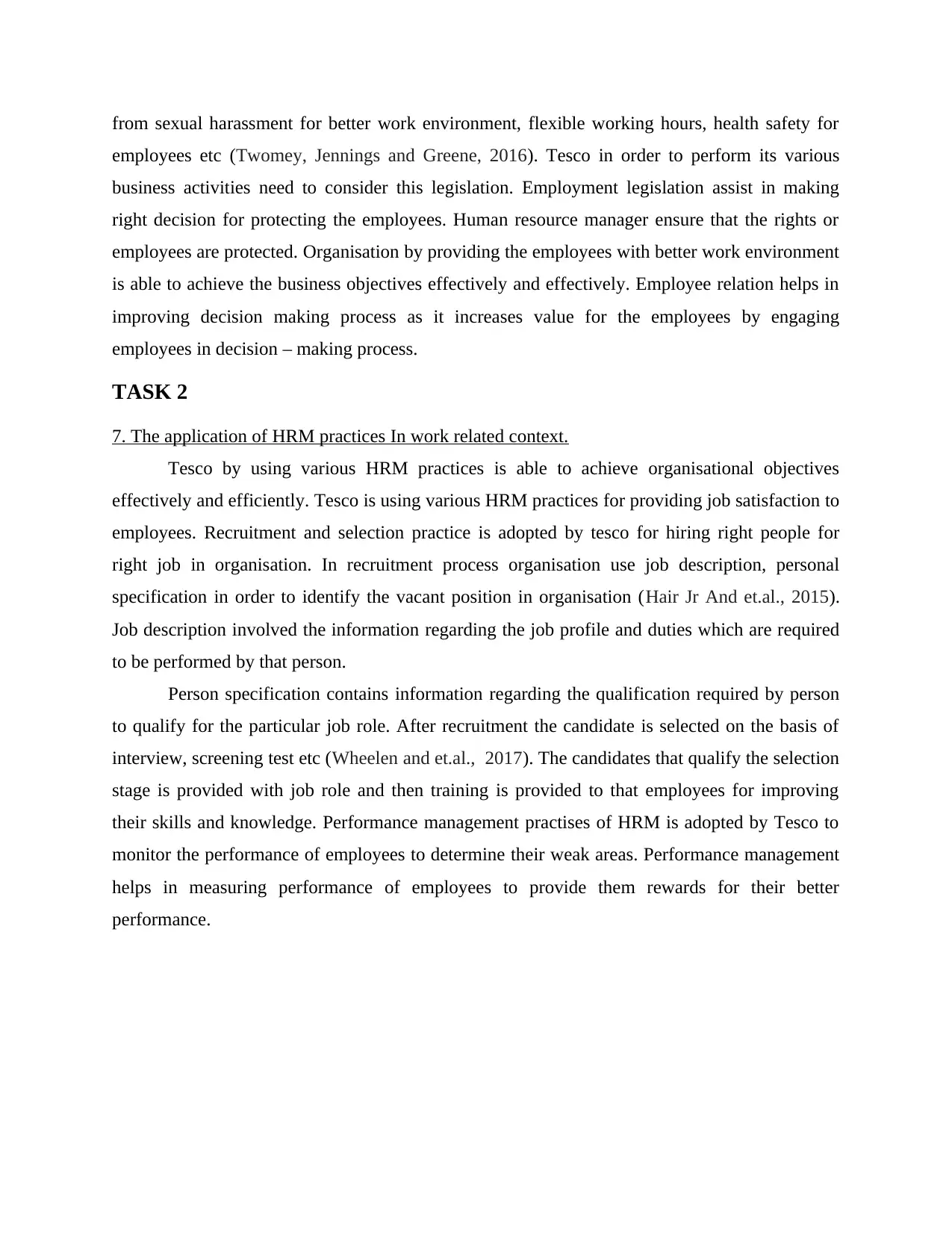
from sexual harassment for better work environment, flexible working hours, health safety for
employees etc (Twomey, Jennings and Greene, 2016). Tesco in order to perform its various
business activities need to consider this legislation. Employment legislation assist in making
right decision for protecting the employees. Human resource manager ensure that the rights or
employees are protected. Organisation by providing the employees with better work environment
is able to achieve the business objectives effectively and effectively. Employee relation helps in
improving decision making process as it increases value for the employees by engaging
employees in decision – making process.
TASK 2
7. The application of HRM practices In work related context.
Tesco by using various HRM practices is able to achieve organisational objectives
effectively and efficiently. Tesco is using various HRM practices for providing job satisfaction to
employees. Recruitment and selection practice is adopted by tesco for hiring right people for
right job in organisation. In recruitment process organisation use job description, personal
specification in order to identify the vacant position in organisation (Hair Jr And et.al., 2015).
Job description involved the information regarding the job profile and duties which are required
to be performed by that person.
Person specification contains information regarding the qualification required by person
to qualify for the particular job role. After recruitment the candidate is selected on the basis of
interview, screening test etc (Wheelen and et.al., 2017). The candidates that qualify the selection
stage is provided with job role and then training is provided to that employees for improving
their skills and knowledge. Performance management practises of HRM is adopted by Tesco to
monitor the performance of employees to determine their weak areas. Performance management
helps in measuring performance of employees to provide them rewards for their better
performance.
employees etc (Twomey, Jennings and Greene, 2016). Tesco in order to perform its various
business activities need to consider this legislation. Employment legislation assist in making
right decision for protecting the employees. Human resource manager ensure that the rights or
employees are protected. Organisation by providing the employees with better work environment
is able to achieve the business objectives effectively and effectively. Employee relation helps in
improving decision making process as it increases value for the employees by engaging
employees in decision – making process.
TASK 2
7. The application of HRM practices In work related context.
Tesco by using various HRM practices is able to achieve organisational objectives
effectively and efficiently. Tesco is using various HRM practices for providing job satisfaction to
employees. Recruitment and selection practice is adopted by tesco for hiring right people for
right job in organisation. In recruitment process organisation use job description, personal
specification in order to identify the vacant position in organisation (Hair Jr And et.al., 2015).
Job description involved the information regarding the job profile and duties which are required
to be performed by that person.
Person specification contains information regarding the qualification required by person
to qualify for the particular job role. After recruitment the candidate is selected on the basis of
interview, screening test etc (Wheelen and et.al., 2017). The candidates that qualify the selection
stage is provided with job role and then training is provided to that employees for improving
their skills and knowledge. Performance management practises of HRM is adopted by Tesco to
monitor the performance of employees to determine their weak areas. Performance management
helps in measuring performance of employees to provide them rewards for their better
performance.
⊘ This is a preview!⊘
Do you want full access?
Subscribe today to unlock all pages.

Trusted by 1+ million students worldwide
1 out of 16
Related Documents
Your All-in-One AI-Powered Toolkit for Academic Success.
+13062052269
info@desklib.com
Available 24*7 on WhatsApp / Email
![[object Object]](/_next/static/media/star-bottom.7253800d.svg)
Unlock your academic potential
Copyright © 2020–2025 A2Z Services. All Rights Reserved. Developed and managed by ZUCOL.





